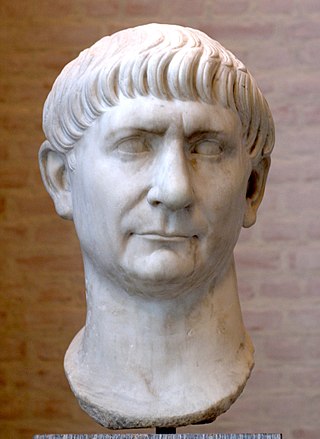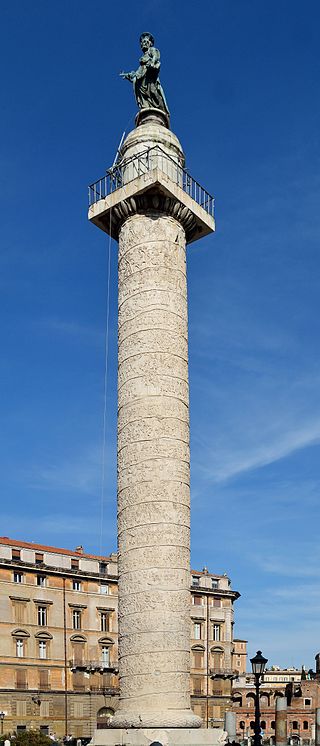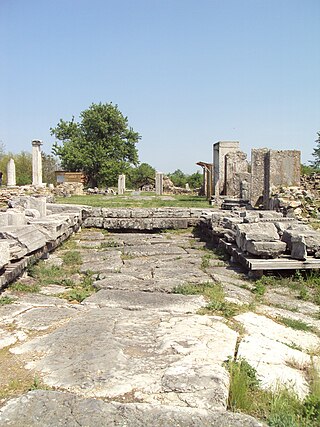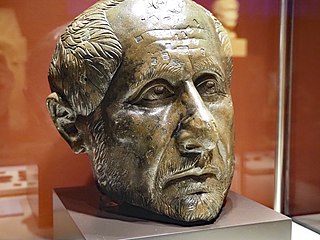
Trajan was a Roman emperor from AD 98 to 117, the second of the Five Good Emperors of the Nerva–Antonine dynasty. He was a philanthropic ruler and a successful soldier-emperor who led the Roman Empire to its greatest territorial extent by the time of his death. He was given the title of Optimus by the Roman Senate.

The 100s was a decade that ran from January 1, AD 100, to December 31, AD 109.

Sarmizegetusa Regia was the capital and the most important military, religious and political centre of the Dacians before the wars with the Roman Empire. Built on top of a 1200 m high mountain, the fortress, consisting of six citadels, was the core of a strategic and defensive system in the Orăștie Mountains.

Trajan's Column is a Roman triumphal column in Rome, Italy, that commemorates Roman emperor Trajan's victory in the Dacian Wars. It was probably constructed under the supervision of the architect Apollodorus of Damascus at the order of the Roman Senate. It is located in Trajan's Forum, north of the Roman Forum. Completed in AD 113, the freestanding column is most famous for its spiral bas relief, which depicts the wars between the Romans and Dacians. Its design has inspired numerous victory columns, both ancient and modern.

Legio XXX Ulpia Victrix was a legion of the Imperial Roman army. Their emblems were the gods Neptune and Jupiter and the Capricorn. Ulpia is Trajan's own gens (Ulpia), while the cognomen "Victrix" means "victorious," and it was awarded after their valiant behaviour in the Dacian wars. The legion was active until the disbandment of the Rhine frontier in the beginning of the 5th century.

Timgad was a Roman city in the Aurès Mountains of Algeria. It was founded by the Roman Emperor Trajan around 100 CE. The full name of the city was Colonia Marciana Ulpia Traiana Thamugadi. Emperor Trajan named the city in commemoration of his mother Marcia, eldest sister Ulpia Marciana, and father Marcus Ulpius Traianus.

The Baths of Diocletian were public baths in ancient Rome. Named after emperor Diocletian and built from AD 298 to 306, they were the largest of the imperial baths. The project was originally commissioned by Maximian upon his return to Rome in the autumn of 298 and was continued after his and Diocletian's abdication under Constantius, father of Constantine.

Apollodorus of Damascus was an architect and engineer from Roman Syria, who flourished during the 2nd century AD. As an engineer he authored several technical treatises, and his massive architectural output gained him immense popularity during his time. He is one of the few architects whose name survives from antiquity, and is credited with introducing several Eastern innovations to the Roman Imperial style, such as making the dome a standard.

The Imperial Fora are a series of monumental fora, constructed in Rome over a period of one and a half centuries, between 46 BC and 113 AD. The fora were the center of the Roman Republic and of the Roman Empire.

Trajan's Forum was the last of the Imperial fora to be constructed in ancient Rome. The architect Apollodorus of Damascus oversaw its construction.

Nicopolis ad Istrum or Nicopolis ad Iatrum was a Roman and Early Byzantine town.

The Basilica Ulpia was an ancient Roman civic building located in the Forum of Trajan. The Basilica Ulpia separates the temple from the main courtyard in the Forum of Trajan with the Trajan's Column to the northwest. It was named after Roman emperor Trajan whose full name was Marcus Ulpius Traianus.

The Basilica of Maxentius and Constantine, sometimes known as the Basilica Nova—meaning "new basilica"—or Basilica of Maxentius, is an ancient building in the Roman Forum, Rome, Italy. It was the largest building in the Forum, and the last Roman basilica built in the city.

The Library of Celsus is an ancient Roman building in Ephesus, Anatolia, today located nearby the modern town of Selçuk, in the İzmir Province of western Turkey. The building was commissioned in the years 110s CE by a consul of the Roman Empire, Tiberius Julius Aquila Polemaeanus, as a funerary monument for his father Tiberius Julius Celsus Polemaeanus, former proconsul of Asia, and completed during the reign of the Roman Emperor Hadrian, sometime after Aquila's death.

Marcia Furnilla was a Roman noblewoman who lived in the 1st century. Furnilla was the second and last wife of the future Roman Emperor Titus as well as the aunt of the future emperor Trajan.

Colonia Ulpia Traiana Augusta Dacica Sarmizegetusa was the capital and the largest city of Roman Dacia, later named Ulpia Traiana Sarmizegetusa after the former Dacian capital, located some 30 km away. Possibly built over a camp of the Fifth Macedonian Legion in about 106 AD, the city was settled by veterans and colonists from Italian peninsula. From the very beginning it received the title of colonia and the status of ius Italicum. The urban centre and the civil settlement occupied an area of over 130 hectares, with a population reaching between 20,000 and 25,000 at the end of the 2nd century beginning of the 3rd. The centre built in a Hippodamian Plan was surrounded by strong fortifications over 32.4 hectares.
Ulpia was a noble Roman woman from the gens Ulpia settled in Spain during the 1st century CE. She was the paternal aunt of the Roman emperor Trajan and the paternal grandmother of the emperor Hadrian.

Terme Taurine, also known as the Taurine Baths, is a large elaborate ancient Roman baths complex located about 4 km east of the city of Civitavecchia.

The Library of Pantainos was a building in ancient Athens. It was located at the southeast end of the Agora of Athens, south of the Stoa of Attalus, on the left side of Panathenaion Street. It was built by the Athenian philosopher Titus Flavius Pantainos between 98 and 102 AD, during the reign of the Roman emperor Trajan. The library building was dedicated to Athena Archegetis, with Trajan himself and the people of Athens, according to an inscription on the lintel of the main entrance, which is preserved embedded in the late Roman wall,.






















